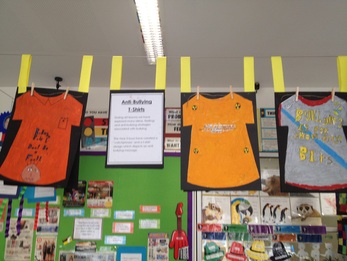Demonstrate an understanding of the relevant issues and the strategies available to support the safe, responsible and ethical use of ICT in learning and teaching.
Standard 4.5

Young people today live an increasingly connected global society. It is imperative that they learn how to communicate in these changing times, safely and responsibily.
Using ICT safely, responsibly and ethically
Cymbersmart is a government iniiative that supports schools in teaching students how to by cybersmart and use the internet safely. The program addresses four capabilities:
Digital Media Literacy
Digital media literacy is the ability to access, understand and participate in or create content by using digital media. Students are introduced to appropriate online content and places such as:
Positive Online Behaviours
Positive online behaviour is the ability to develop positive, appropriate and constructive online relationships with peers, family and strangers in a variety of mediums. Concepts for positive online behaviour include:
Respectful communication/netiquette
Cyberbullying
Peer and Personal Safety
Peer and personal safety involves developing protective behaviours while using a range of online media including social networking.
Concepts for peer and personal safety include:
Protective behaviours
e-Security
e-Security is broadly defined as the protection of personal information online. It involves both electronic security and online security. Concepts for e-Security include:
Safe technology use
- Digital media literacy
- Positive online communication
- Peer and personal safety and
- e-Security
Digital Media Literacy
Digital media literacy is the ability to access, understand and participate in or create content by using digital media. Students are introduced to appropriate online content and places such as:
- Analysing online symbols
- Identifying avatars as online constructs
- Violence in games does not reflect real life behaviours
- Compares strangers in the physical world to strangers online.
Positive Online Behaviours
Positive online behaviour is the ability to develop positive, appropriate and constructive online relationships with peers, family and strangers in a variety of mediums. Concepts for positive online behaviour include:
Respectful communication/netiquette
- Including not excluding
- Appropriate language to others
- Being kind when online
- Trusted adults and online help
- Personal information—protecting it.
- Appropriate contact
- Adult supervision
- Sharing personal information
- Responding to unwelcome contact.
Cyberbullying
- Identifying forms
- Responding to
- Preventing
- Role of bystander
- Reporting.
Peer and Personal Safety
Peer and personal safety involves developing protective behaviours while using a range of online media including social networking.
Concepts for peer and personal safety include:
Protective behaviours
- Privacy
- Grooming process
- Identifying feeling unsafe
- Trusted adults and online help
- Personal information—protecting it.
e-Security
e-Security is broadly defined as the protection of personal information online. It involves both electronic security and online security. Concepts for e-Security include:
Safe technology use
- email, spam, pop-ups, viruses.
Inside the classroom

During a unit on bullying, Grade 5 boys designed their own anti-bullying T-Shirts.
Cyberbullying (Middle Primary)
This unit aims to help students to:
By the end of this unit, students will be able to:
Sequence of work
This unit comprises six activities, each 45 minutes long including:
Activity 1: What is bullying?
As a class discuss what is meant by bullying. On butcher's paper, make a list of behaviours or acts that could be considered bulllying. Display this in the classroom so more ideas can be added throughout the unit (for more information visit www.bullyingnoway.com.au).
Ask students to think of a time when they, or someone they know, were bullied (remembering not to mention names) and how they felt at the time. Students to complete Worksheet 1, using personal experiences, feelings etc. to show their understanding of bullying. Students should include words, drawings, magazine pictures, etc. to help illustrate their understanding. If students feel comfortable, they can share their mindmaps in pairs for further discussion. Refer back to the list of behaviours and acts created at the start of the lesson and add any new ideas that have arisen during completion of the worksheet.
Source: www.cybersmart.com.au
This unit aims to help students to:
- develop an understanding of bullying and cyberbullying and the similarities and differences between them
- recognise the different roles of people involved in bullying situations, especially bystanders
- acknowledge the effects of cyberbullying on the people involved.
By the end of this unit, students will be able to:
- compare and contrast bullying and cyberbullying
- describe the roles and responsibilities of people involved in bullying
- list strategies to deal with cyberbullying.
Sequence of work
This unit comprises six activities, each 45 minutes long including:
- What is bullying?
- Who is involved in bullying?
- Exploring the role of the bystander
- Cyberbullying, what is it?
- Considering the effects of cyberbullying
- Preventing cyberbullying
Activity 1: What is bullying?
As a class discuss what is meant by bullying. On butcher's paper, make a list of behaviours or acts that could be considered bulllying. Display this in the classroom so more ideas can be added throughout the unit (for more information visit www.bullyingnoway.com.au).
Ask students to think of a time when they, or someone they know, were bullied (remembering not to mention names) and how they felt at the time. Students to complete Worksheet 1, using personal experiences, feelings etc. to show their understanding of bullying. Students should include words, drawings, magazine pictures, etc. to help illustrate their understanding. If students feel comfortable, they can share their mindmaps in pairs for further discussion. Refer back to the list of behaviours and acts created at the start of the lesson and add any new ideas that have arisen during completion of the worksheet.
Source: www.cybersmart.com.au
Cybersmart Policies in South Australia
Catholic Education South Australia
Approach to cybersafety Catholic Education South Australia (CESA) notes that cybersafety governance within CESA schools is determined at a school level. Catholic Education South Australia does provide links to a number of policy documents that have been approved by SACCS (South Australian Commission for Catholic Schools). These overarching policy documents are listed below.
- ICT security SACCS ICT Security Policy 2007
- Cyberbullying policy Cyber Bullying and e-Crime
- Cyber bullying e-crime and the protection of children
Department of Education and Children's Services
Approach to cybersafety In matters relating to cybersafety, DECS works with, and is advised by:
- the Keeping Safe: Child Protection Curriculum - a child protection teaching and learning program in South Australian government schools and preschools, developed by experienced South Australian educators and child protection experts. the Abuse and Neglect Training program (previously Mandatory Notification Training).
- the Australian Communications and Media Authority (ACMA), which manages a national cybersafety education and awareness program and is also responsible for monitoring online content, including Internet and mobile phone content, and enforcing Australia's anti-spam law.
- South Australia Police (SAPol).
- the Coalition to Decrease Bullying, Harassment and Violence in South Australian Schools, which has representatives from the three schooling sectors and eminent international researchers Professor Ken Rigby, Professor Phillip Slee and Drs Barbara Spears and Shoko Yoneyama.
